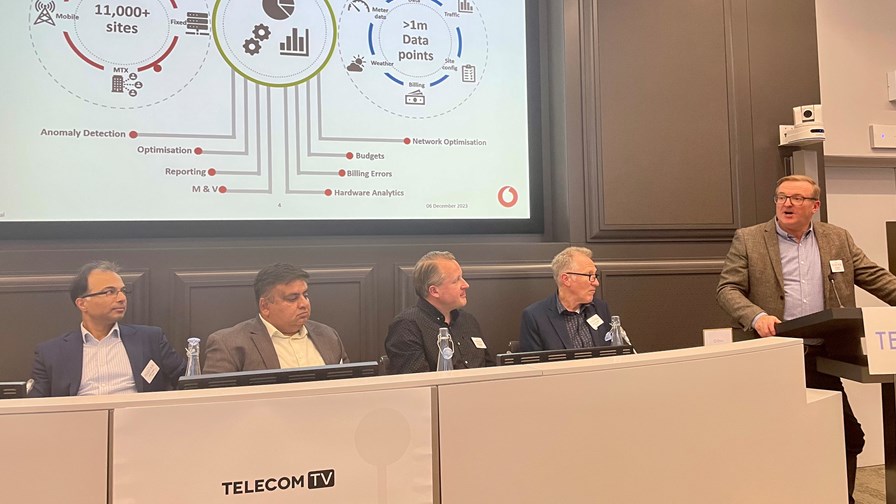
Panel discussion, 'Using AI to help with energy efficiency', at the Telcos & AI event. Source: TelecomTV
- Energy efficiency was a hot topic at TelecomTV’s in-person event in London dedicated to AI in the telecom sector
- Vodafone UK would love to see AI tools enable ‘zero-traffic, zero-watt’ operations in its radio access network
- AI capabilities that can help to deliver energy savings are already available, according to our panellists
LONDON – Telcos & AI – Vodafone UK would like to achieve a ‘zero-traffic, zero-watt’ scenario in its radio access network – whereby no power is used when there is no traffic running over the network – and the telco is exploring how it can best use AI and big data to increase energy efficiency.
This was one of the key notions from Lee Jones, senior manager of energy at Vodafone UK (pictured above, far right), during the panel discussion ‘Using AI to help with energy efficiency’ at the Telcos & AI event, which gathered together numerous telecom experts in the heart of London, including high-level executives from operators, vendors and analyst firms.
The UK operator seeks to minimise its environmental footprint by ensuring that it operates in a way that its networks consume no energy when there is no traffic carried over it, explained Jones.
He noted that while Vodafone has historically been using big data in other areas, it is only recently that energy has become “one of the biggest use cases across Vodafone Group and UK” for big data, AI and machine learning (ML). A lot of that, he noted, is driven by energy price increases.
In fact, Jones explained, Vodafone UK’s energy bill this year is “horrendous”, reaching somewhere between £150m and £160m, which has put pressure on the telco to come up with new ways of reducing its energy consumption. The supply chain has become critical to this, as the telco now has power purchase agreements (PPAs) and open trade in place.
Nowadays, he added, Vodafone UK is using AI and big data a lot, as the operator has numerous telecom exchanges, datacentres and approximately 11,000 radio base stations and offices which, combined, represent a lot of data points and metadata.
“We pride ourselves that we’re getting 99.8% data quality from our smart metering,” which is used for making informed decisions, said Jones. The data is being put into what he described as a “big data mixing bowl” and an internal team of data scientists works with it to detect anomalies, locate problems and identify where the company can make money. This can unlock “real, tangible bottom-line opex [operating expenditure] savings,” he added.
The Vodafone UK expert pointed out that the challenge for telcos is not knowing which energy-saving software features, such as sleep mode, are switched on across thousands of sites. “There are not a lot of tools in the OSS [operations support systems] to manage that.” When decision-makers are putting “a dollar sign to this or a pound sign to that” and highlight that there is a lost opportunity in not having these features turned on, “you really get the attention,” explained Jones.
Finally, he insisted that Vodafone is using “every tool we can to drive change in an energy budget”.
And Vodafone UK is not the only operator to be looking at AI for energy use optimisation. In the opening session of the event, ‘Developing the AI-powered RAN’, BT’s director of network and spectrum strategy, Mark Henry, noted that the telco group’s top priority for using AI is indeed energy efficiency.
Azfar Aslam, Nokia’s CTO for Europe (pictured above, far left), argued that achieving energy efficiency in telecoms depends on the “holy trinity” of how the silicon is designed, how the network is built and the way AI is used to expand the switch-off period in networks. He explained that AI is already capable of this switch-off and optimising energy consumption, but the question is “do we have enough confidence to use it?”
Similar conclusions were arrived at by Manish Singh, CTO of telecom systems business at Dell Technologies (pictured above, second from left). He said that using AI and ML provides a “massive opportunity” to obtain the data needed to increase energy savings. The technology could help with learning processes and could then start predicting outcomes in terms of network operation and efficiency.
Dean Ramsay, principal analyst at TM Forum (pictured above, middle), noted that one thing that AI is good at is pooling information together and gathering data analytics to weed out inefficiencies across the network.
But the session also raised one of the main challenges associated with using AI to help with energy efficiency efforts – running the AI applications themselves requires significant power, which means the net result in terms of energy efficiency might be negligible at best. And that particular challenge doesn’t look to be disappearing any time soon…
- Yanitsa Boyadzhieva, Deputy Editor, TelecomTV
Email Newsletters
Sign up to receive TelecomTV's top news and videos, plus exclusive subscriber-only content direct to your inbox.




